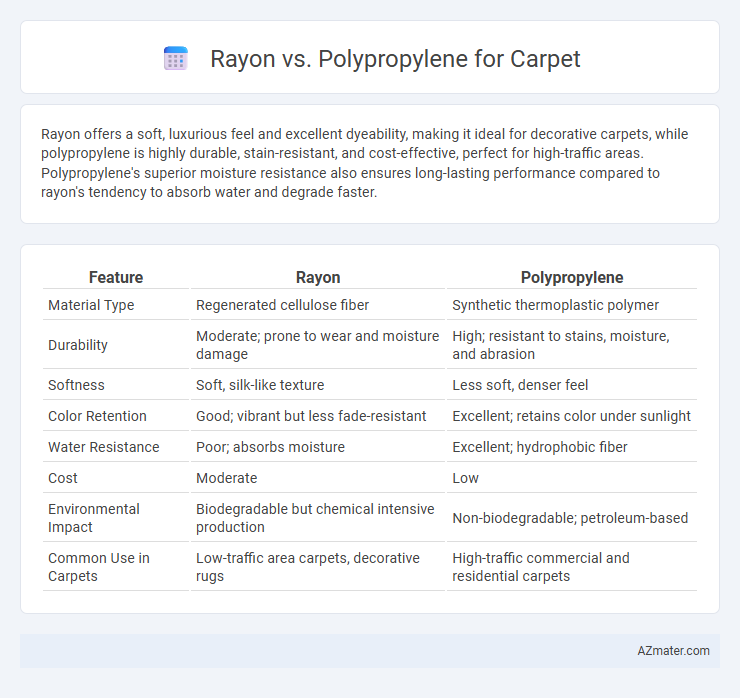Rayon offers a soft, luxurious feel and excellent dyeability, making it ideal for decorative carpets, while polypropylene is highly durable, stain-resistant, and cost-effective, perfect for high-traffic areas. Polypropylene's superior moisture resistance also ensures long-lasting performance compared to rayon's tendency to absorb water and degrade faster.
Table of Comparison
| Feature | Rayon | Polypropylene |
|---|---|---|
| Material Type | Regenerated cellulose fiber | Synthetic thermoplastic polymer |
| Durability | Moderate; prone to wear and moisture damage | High; resistant to stains, moisture, and abrasion |
| Softness | Soft, silk-like texture | Less soft, denser feel |
| Color Retention | Good; vibrant but less fade-resistant | Excellent; retains color under sunlight |
| Water Resistance | Poor; absorbs moisture | Excellent; hydrophobic fiber |
| Cost | Moderate | Low |
| Environmental Impact | Biodegradable but chemical intensive production | Non-biodegradable; petroleum-based |
| Common Use in Carpets | Low-traffic area carpets, decorative rugs | High-traffic commercial and residential carpets |
Introduction to Carpet Fiber Choices
Carpet fiber choices significantly impact durability, appearance, and maintenance, with rayon and polypropylene being common options. Rayon offers a soft texture and vibrant color retention but is less resistant to moisture and wear compared to polypropylene. Polypropylene, known for its stain resistance and affordability, suits high-traffic areas while maintaining colorfastness and ease of cleaning.
What is Rayon?
Rayon is a semi-synthetic fiber made from regenerated cellulose derived from wood pulp, offering a soft and luxurious feel similar to natural fibers like silk. It features excellent dye absorption, resulting in vibrant and rich colors ideal for carpet designs. Compared to polypropylene, rayon provides superior breathability and a more natural appearance but typically has lower durability and moisture resistance.
What is Polypropylene?
Polypropylene is a synthetic thermoplastic polymer widely used in carpet manufacturing due to its durability, stain resistance, and affordability. It features hydrophobic properties, making it resistant to moisture, mold, and mildew, which is ideal for high-traffic and moisture-prone areas. Compared to rayon, polypropylene provides better color retention and easier maintenance, contributing to its popularity in residential and commercial carpeting.
Durability Comparison: Rayon vs Polypropylene
Polypropylene carpets exhibit superior durability due to their resistance to stains, moisture, and abrasion, making them ideal for high-traffic areas. Rayon, while offering a luxurious appearance and softness, tends to wear out more quickly and is less resistant to moisture and staining. For long-lasting performance and easier maintenance, polypropylene is the preferred choice over rayon in carpet applications.
Stain Resistance and Maintenance
Polypropylene carpets exhibit superior stain resistance compared to rayon, as their synthetic fibers repel moisture and resist most common household stains, making them easier to clean. Rayon, a semi-synthetic fiber derived from cellulose, is more prone to water-based stains and may require specialized cleaning products to maintain its appearance. Maintenance of polypropylene carpets is simpler and more cost-effective due to their durability, while rayon carpets demand more frequent and careful upkeep to avoid fiber damage and discoloration.
Comfort and Texture Differences
Rayon carpets offer a soft, silky texture that closely mimics natural fibers, providing exceptional comfort underfoot, while polypropylene carpets tend to have a firmer, more synthetic feel. Rayon fibers absorb moisture, which enhances their plushness but may affect durability in high-traffic areas; polypropylene is moisture-resistant, making it less prone to crushing and easier to clean. The choice between rayon and polypropylene largely depends on the desired balance between luxurious comfort and practical durability in carpet applications.
Environmental Impact and Sustainability
Rayon carpets, derived from natural cellulose fibers, are biodegradable but involve energy-intensive chemical processing that raises environmental concerns. Polypropylene carpets, made from non-renewable petroleum-based polymers, are less biodegradable but require less energy to produce and offer high durability, reducing replacement frequency. Considering sustainability, rayon offers a renewable source but with chemical pollution risks, while polypropylene provides longevity with challenges in biodegradability and recycling.
Cost and Value Considerations
Rayon carpets offer a luxurious appearance and soft texture but come at a higher price point compared to polypropylene, which is more budget-friendly and durable. Polypropylene resists stains, moisture, and fading, delivering excellent value for high-traffic areas and households with pets or children. Cost-conscious buyers often prefer polypropylene for its long-term resilience, while rayon appeals to those prioritizing aesthetic quality despite its higher maintenance and replacement costs.
Best Applications for Each Fiber
Rayon fibers excel in luxurious, soft carpets ideal for residential spaces and low-traffic areas due to their silk-like texture and vibrant dye absorption. Polypropylene, known for its stain resistance, durability, and affordability, is best suited for high-traffic commercial environments and outdoor carpeting. Each fiber's performance is maximized when matched to the carpet's required durability, maintenance, and aesthetic demands.
Final Recommendations: Choosing the Right Carpet
Rayon offers a soft, luxurious feel ideal for low-traffic areas, but its lower durability and higher moisture sensitivity make it less suitable for high-traffic or damp environments. Polypropylene provides superior stain resistance, excellent durability, and moisture-wicking properties, making it the best choice for high-traffic, indoor/outdoor, and moisture-prone settings. For long-lasting carpets in busy areas, polypropylene remains the optimal selection, while rayon works well for budget-friendly, decorative use with minimal wear.

Infographic: Rayon vs Polypropylene for Carpet
 azmater.com
azmater.com